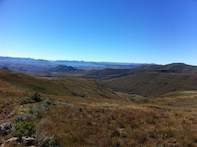Bridges, Roads and Railway
Back in the day, there was a period of four months during which Boer forces occupied Barkly East and the Free State flag fluttered over the courthouse (today it’s the post and magistrates’ offices painted a garish pale blue—you can’t miss it).

During the war when, after proclaiming Barkly East a republic, mounted Cape Boer rebels rode in single file into the bar and out through the kitchen of the old Royal Hotel as an act of bravado and to show solidarity with their brothers across the Orange.
Barkly East, being an isolated border town, suffered from lack of contact with the outside world in its early years. They were sometimes snowed in, often threatened by frontier raiders, rivers washed roads away and mountains made communication difficult.
The post-cart was occasionally dragged downstream with the postman having to swim for it; the drifts were dangerous and the punt that ferried people was too flimsy to take any large traffic.
It was for this reason that the town clamoured for bridges, serviceable roads and a railway link to the outside world. They pestered the authorities until plans were set in motion for a railway line and kept badgering them for the next thirty years as the iron tracks crept closer.
Two Formidable Obstacles
The terrain around Barkly East made road and railroad building hazardous: in one nearby valley two formidable obstacles had to be overcome: the Kraai River and the steep hills adjacent to it. The beautiful Loch Bridge over the recalcitrant Kraai was a vital step in bringing a serviceable road to town.
Likewise the railway reverses - eight reversing stations for the engine to negotiate a very steep gradient (1 in 36) brought the tracks even closer. The latter - I was told over a pint at the sports bar - is one of only two such reversing lines in the world and until recently would attract gricers who marvelled at the huffing engines.
Barkly East is no longer served by steam, but an old 19D locomotive stands on the town square, a reminder of the town’s determination to connect to the country.
By Justin Fox